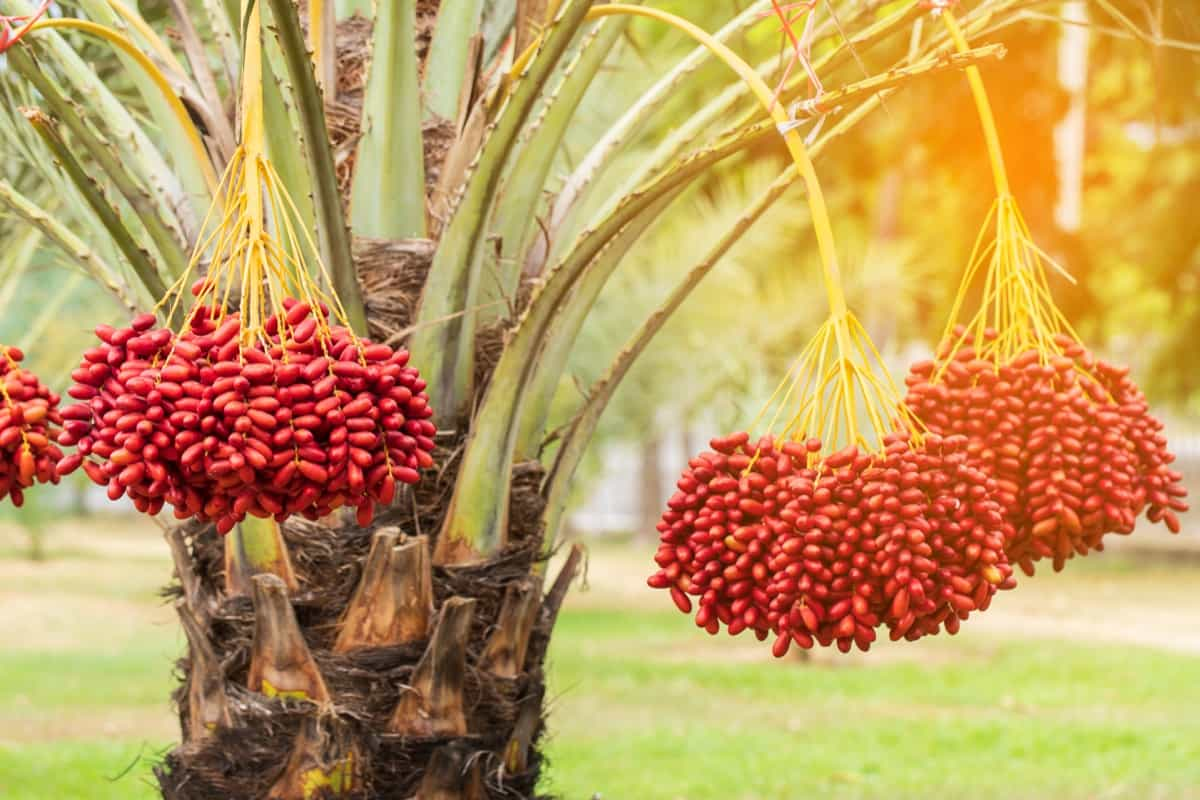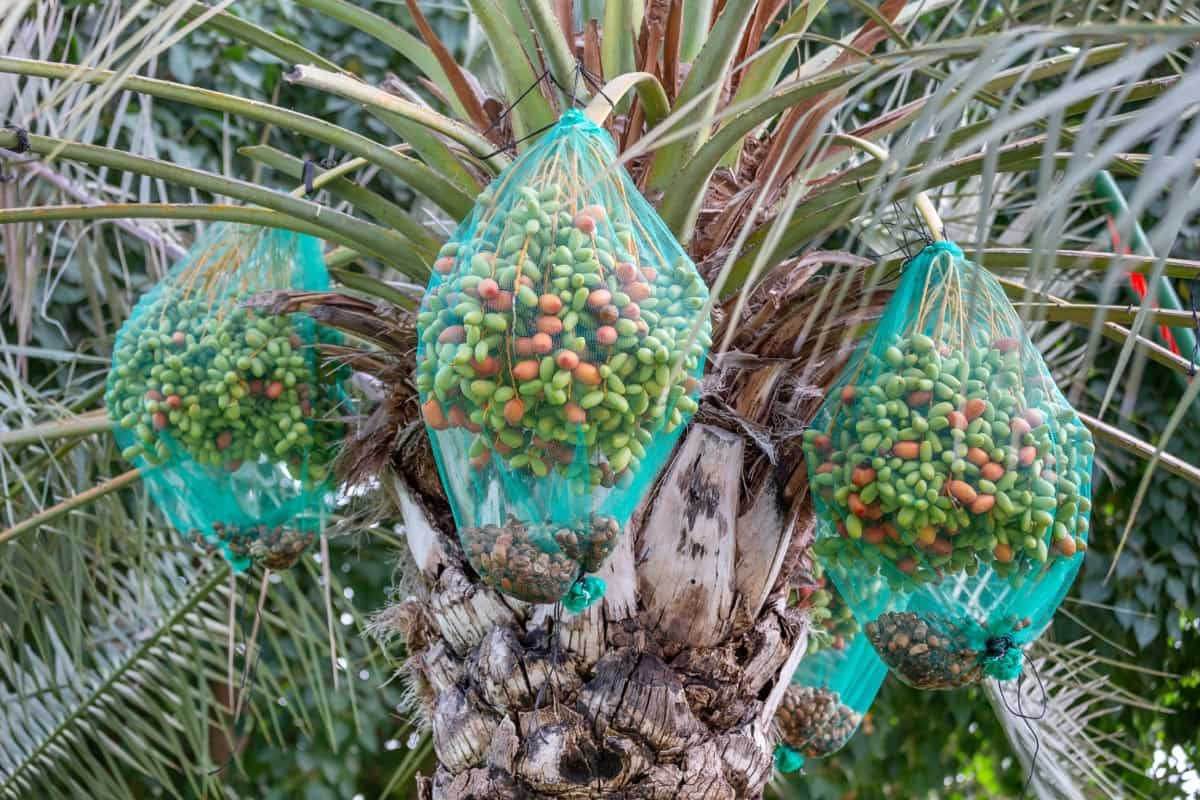The cost and profit analysis of date palm farming on a 1-acre farm is crucial. A comprehensive project report and economic assessment are essential for understanding the investment required and potential returns. It is important to analyze the data meticulously, considering factors such as initial investment, ongoing expenses, yield projections, market demand, and pricing trends to determine the profitability of date palm farming on a 1-acre plot.

What is Date Palm Farming?
The date palm is an impressive tree, growing up to 23 meters (75 feet) tall, with a distinct stem marked by pruned leaf bases. It boasts a crown of beautiful, glossy, pinnate leaves measuring around 5 meters (16 feet) in length. Floral spikes emerge from the previous year’s leaf axils, with separate male and female flowers.
Cultivated date palms are artificially pollinated, resulting in oblong, one-seeded fruits known as drupes. A bunch can contain over 1,000 dates, weighing 8 kg (18 pounds) or more. Date palms can be propagated through seeds or offshoots, which are commercially used for planting. Offshoots are removed and planted once they have formed their roots, typically at 3 to 6 years of age.
Overview of DatePalm Trees: Biology, Production, and Uses
The date palm (Phoenix dactylifera) is a cultivated tree renowned for its delicious sweet fruits. It is believed to have originated in present-day Iraq and has been highly valued since ancient times. Date palms thrive in the irrigable deserts of North Africa, the Middle East, and beyond, serving as a vital source of sustenance and wealth.
Today, they are grown in various regions, including the Canary Islands, northern Africa, the Middle East, Pakistan, India, Mexico, and California, USA.Dried dates, such as the popular deglet noor variety, possess an extended shelf life and are rich in sugar (over 50% by weight).
Every part of the date palm is utilized for economic purposes. Its trunk provides timber, the midribs of leaves are used for furniture and crates, leaflets for basketry, leaf bases for fuel, fruit stalks for rope and fuel, fiber for cordage and packaging, and seeds as stock feed. The fruit yields syrup, alcohol, vinegar, and liquor.
Highest Production of Date Palm: Egypt takes the lead as the world’s largest producer of dates, surpassing Iran and Algeria, which hold the second and third positions. With an annual production of 1.5 million tons, Egypt showcases its significant contribution to the date palm industry.
Highest Production of Date Palm in India: The Kutch district in Gujarat, India, holds the distinction of being the largest producer of date palm in the country. Covering approximately 18,286 hectares, the region produces around 171,522 metric tons of fresh date fruits, showcasing its significant contribution to India’s date palm industry.
Market and Demand for Date Palm Farming
In 2020, the global market for date palm was valued at approximately $13.06 billion, and it is projected to reach $19.76 billion by 2026. Growth in the market is fueled by various factors, including the recognized health benefits of date palm, its expanding use in ethnic snacks, and the rising demand for date palm kernel oil. North America is expected to be the leading market, driven by the high demand for date palms among snack manufacturers and the increasing interest in functional food products.
Best High-Yielding Variety for Date Palm Farming
Barhee Dates, an effective date palm variety, feature a sizable trunk and medium height. Its fruit stalks are long, broad, and weighty. The cylindrical fruits exhibit a range of colors, from light brown to dark brown. On the other hand, Medjool Dates are known for their rapid growth, with an impressive rate of 12 to 18 inches per year.
Some popular soft-fleshed varieties include Halawy, Medjoot, Shamran (Sayer), Hayani, Khadrawy, and Saidy. Dry and semi-dry fleshed varieties include Zahidi, Thoory, Noor, Deglet, and Dayari. Non-astringent varieties include Halawy, Barhee, Chip Chap (Kip Kap), Bureim, Shaker, and Shahaani. Khadrawy, Zahidi, and Medjoot are known for Chaharamaking, while Zahidi is favored for Pind Khajoormaking.
Best Package and Practices for Date Palm Farming
Climate Requirements for Date Palm Farming: Date palm production relies on specific climatic conditions. It necessitates a long, warm winter, no rainfall during flowering and fruiting, low relative humidity, and ample sunlight. The ideal temperature range for flowering and fruiting is above 70 degrees Fahrenheit, with at least a month of temperatures above 80 degrees Fahrenheit required for proper ripening.
Mode of Propagation in Date Palm Farming: The most common propagation method is through offshoots or suckers. These offshoots are obtained from the base of the mother tree and separated after 4-5 years of planting. Each tree can produce 9-20 suckers weighing 9-15 kg between the 4th and 10th years, with a potential yield of 10-25 offshoots throughout its productive life. Propagation through seeds is generally avoided due to poor fruit quality and the production of non-bearing male plants. Tissue culture is another technique used for the rapid multiplication of date palms.
In case you missed it: How to Grow and Care for Sago Palm: A Comprehensive Guide for Beginners

Sowing Process for Date Palm Farming: The sowing process involves thorough soil preparation, including plowing the soil 2-3 times, leveling it, and bringing it to a fine tilth stage. Pits of 1m x 1m x 1m are dug during summer in preparation for the monsoon season. The pits are left open for 15 days before being filled with well-rotted farm yard manure (FYM) and soil. The plantation is then carried out, with February and March considered the best time for planting. In certain regions like Kutch, India, plantation begins during the monsoon season’s beginning.
Intercropping in Date Palm Farming: Since date palm plants have a long lifespan, intercropping with pulses like gram, peas, lentils, and vegetables is feasible. Pomegranate and papaya can also be grown as intercrops. Additional irrigation and nutrient management are essential when practicing intercropping.
Pruning in Date Palm Farming: Pruning is necessary for maintaining an optimal number of green leaves for growth and yield. During the bearing stage, it is recommended to have 75-100 leaves on the tree. No pruning is required for the first 4-5 years, as the tree produces up to 20 leaves annually. Maintaining an appropriate leaf bunch ratio is crucial for enhancing fruit quality and preventing diseases such as Blacknose disease caused by high humidity.
Pollination in Date Palm Farming: Date palms are dioecious and heavily cross-pollinated in nature. Only 5-10% of male plants are required to pollinate 100 female plants. In commercial production, pollination is often done manually or with machines, typically using three male flower strands per female flower strand. Pollination significantly affects date fruits’ size, quality, and ripening time.
Fertilizers in Date Palm Farming: For rainfed areas, each tree requires 30-40 kg of farm yard manure (FYM) and 200 g each of Nitrogen, Phosphorus, and Potassium (NPK). In irrigated areas, 50-60 kg of FYM and 200 g of NPK per tree are necessary. Application of FYM, half of N, and full P and K should be made in September-October, with the remaining half of N applied in January-February. Green manuring with rotting leguminous cover crops can also be beneficial.
Pests and Diseases in Date Palm Farming: Common pests include the Black Headed Caterpillar, Red Weevil/Indian Palm Weevil, Rhinoceros Beetle/Black Palm Beetle, Scale Insects, and Birds. Diseases like False Smut/Graphiola Leaf Spot can be controlled using fungicides and a Bordeaux mixture.
Harvesting in Date Palm Farming: Dates are harvested based on their growth and ripening stages, as they are consumed at different maturity levels.
Project Report of 1-Acre Date Palm Farming
The components included in the cost of cultivation for Date Palm farming typically consist of seeds, land preparation, fertilizers, organic manure/compost, irrigation, weed management, pest and disease control, harvesting and threshing, postharvest management, and miscellaneous expenses.
- Land Acquisition: The cost of purchasing or leasing 1 acre of land suitable for Date Palm farming.
- Infrastructure Setup: Expenses related to establishing necessary infrastructure such as fencing, irrigation systems, and storage facilities.
- Planting Materials: Cost of Date Palm tree saplings or cuttings required for planting on the entire 1-acre farm.
- Operational Expenses: Regular expenses for labor, fertilizers, pesticides, mulching materials, and other inputs needed for Date Palm cultivation.
- Irrigation Costs: Investment in irrigation systems, including drip irrigation or sprinklers, to provide adequate water to the trees.
- Maintenance and Pruning: Cost of regular maintenance activities, including pruning, weeding, and tree care.
- Harvesting and Postharvest Expenses: Expenses associated with the harvest, including labor, packaging materials, transportation, and storage.
| Component | Cost ($ USD) |
| Land Preparation | 250 |
| Seedlings/Offshoots | 500 |
| Fertilizers | 200 |
| Irrigation | 300 |
| Labor | 400 |
| Pesticides | 100 |
| Miscellaneous Expenses | 246 |
| Total Cost | 2196 |
Total Returns and Net from 1Acre Date Palm Farming
- Cost of cultivation: $2196 Yield per acre: 3.81 tonnes (or 3810 kilograms) Price per 1 kg of date palm: $2.44
- Total Returns: Total Returns = Yield per acre x Price per kg
- Total Returns = 3810 kg x $2.44/kg Total Returns = $9302.40 USD
- Net Returns: Net Returns = Total Returns – Cost of Cultivation
- Net Returns = $9302.40 – $2196 Net Returns = $7106.40 USD
Therefore, the total returns from 1-acre date palm farming would be $9302.40, and the net returns after deducting the cost of cultivation would be $7106.40.
In case you missed it: 1 Acre Oil Palms Cultivation Project Report in India: Production Cost and Profit

Challenges and Risks in Date Palm Farming
Engaging in date palm farming presents various challenges and risks. These include susceptibility to diseases and pests, such as bayoud disease and red palm weevils, which can devastate plantations. Climatic factors like extreme temperatures, drought, and salinity can also affect the health and yield of date palms. Market fluctuations, price volatility, and competition also pose risks to profitability. Effective disease management, climate adaptation strategies, and market analysis are essential for mitigating these challenges.
Conclusion
Conducting a thorough cost and profit analysis for 1-acre date palm farming is crucial to assess the project’s economic viability. Considering the initial investment, ongoing expenses, yield projections, and market dynamics, this analysis enables informed decision-making. It provides insights into the potential profitability of date palm farming on a 1-acre plot.
- Feed Your Flock for Less: Top 10 Tips to Save on Chicken Feed
- Ultimate Guide to Ossabaw Island Hog: Breeding, Raising, Diet, and Care
- Hatching Answers: The Top 10 Reasons Your Chickens Aren’t Laying Eggs
- Eggs and Economics: Breaking Down the Cost of Raising Backyard Chickens
- Defend Your Greens: Proven Methods to Keep Iguanas Out of Your Garden
- Ultimate Guide to Cinnamon Queen Chicken: A Comprehensive Guide for Beginners
- Ultimate Guide to California Tan Chicken: Breeding, Raising, Diet, Egg-Production and Care
- Ultimate Guide to Marsh Daisy Chicken: Breeding, Raising, Diet, and Care
- 10 Types of Chicken Farming Businesses You Can Start for Profits